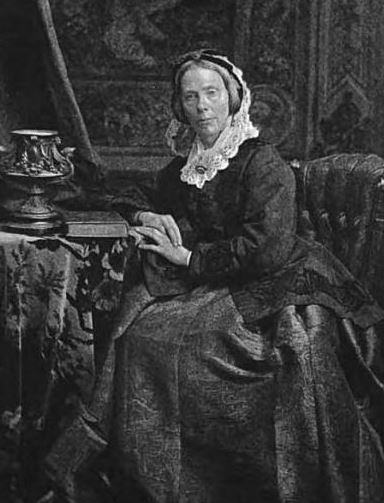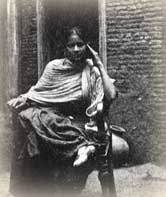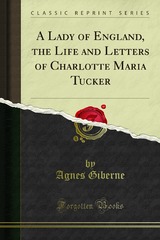It is sweet to be somebody’s sunshine. (From a letter by Charlotte to her sister.)
Charlotte Maria Tucker (May 8, 1821 – December 2, 1893) was born in England to prominent wealthy parents.
Her father had an important position in the government and was at one time the director of the East India Company. Though Charlotte grew up in luxurious circumstances she always had a missionary heart.
Starting in 1851, at age 30, Charlotte wrote many books under the pen name of A.L.O.E. (A Lady of England). Her books became familiar all over the English-speaking world. Charlotte wrote more than 150 stories for young people that were collected into many books. She very often gave away the earnings from her books to missions or other charity work. Popular titles include, “The Rambles of a Rat” and “Pomegranates from the Punjab”. These and many more are in print today and available. She lived at home until age 54. Then she went to India never to return again.
Charlotte is remembered for being a missionary to India as well as a writer. Most missionaries go to the field when they are young. Charlotte went in the last quarter of her life.
 In 1875 Charlotte traveled to India, in the Punjab region, first in Amritsir and then in Batala. She learned the language of the Punjab and was thus enabled to go into the Zenanas and to visit the women in the surrounding villages.
In 1875 Charlotte traveled to India, in the Punjab region, first in Amritsir and then in Batala. She learned the language of the Punjab and was thus enabled to go into the Zenanas and to visit the women in the surrounding villages.
A Zenana was a harem in India usually reserved for the high cast women. The women were not allowed to leave to go anywhere. They were not allowed to have visitors unless the husband gave permission. Charlotte managed to befriend some men and receive permission to visit the women. She was very bold on her visits. Charlotte read the Bible. She learned Hindustani so that she could tell the women about Jesus. The women in the Zenanas loved to get visits from her. By the time she died Charlotte had access to 170 homes.
Another reason that Charlotte was able to visit in the Zenanas was because she did her best to fit in with the Indian people. The other missionaries tried to get her to dress as in English fashion but Charlotte insisted on dressing as the Indians did. When Charlotte would visit in Zenanas or go to church she sat on the floor as the Indians did in spite of her age.
Charlotte considered her greatest work for the Indian people to be the Christian literature that she prepared for the women of India. This was a great legacy for which many women in India were very grateful. Charlotte’s books were translated into many Indian languages – Urdu, Panjabi, Hindi, Bengali, and Tamil. They were sold at exceedingly low prices so that many could afford them. Hundreds of thousands of copies were sold. Some titles include, “A Wreath of Indian Stories” and “Pearls of Wisdom.” This latter book was written at the request of the Christian Vernacular Education Society for India. It was an interpretation of the parables of Jesus.
Charlotte was probably the first woman to write story books in the Indian language. Her family thought that if anything the books were better in Hindustani. Charlotte’s style of writing suited the Eastern way of thinking. She believed that God had prepared her during her earlier life to leave this lasting legacy for the Indian people. Charlotte wrote over 100 books while in India, the last book within a year of her death (“The Forlorn Hope”).
Charlotte thought highly of doing her duty and rarely took a break. When she did she visited other parts of India.  She said that the reason she never went home to England was because saying “good-bye” was too painful. Instead she kept in contact with her family, especially her beloved sister by writing hundreds of letters which are still available to read. Many are collected in her biography by Agnes Giberne, “Lady of England: The Life and Letters of Charlotte Maria Tucker”.
She said that the reason she never went home to England was because saying “good-bye” was too painful. Instead she kept in contact with her family, especially her beloved sister by writing hundreds of letters which are still available to read. Many are collected in her biography by Agnes Giberne, “Lady of England: The Life and Letters of Charlotte Maria Tucker”.
Day in and day out Charlotte lived in an old building which had become her home. She loved the “little brown boys” at the Indian high school where she helped. Year after year she persisted in her round of Zenana visits never giving up even though the results were small. “She had to plough for the Master of the harvest; and she was content to leave results with Him.” (Pg. 331)
Though Charlotte had had numerous trials in the course of her seventy-two years she had led a very happy life. She had freedom from money cares, success in her many interests, and an abundance of loving and steadfast friends. She was close to many friends because of her natural buoyancy and a keen sense of fun.
Many unmarried women in her place would have been more morose, but Charlotte was so unselfish that she was grateful and happy to be where she was. She experienced real joy in giving. Disappointments only spurred her on to try harder.
Above all Charlotte had a strong sense of the “other world”. Spiritual things were absolutely real to her. Christ’s love meant more than the love of all of her friends. It was not that she could not enjoy this world, but that she longed for the next world. She believed that the next world was higher, brighter, and nearer to God.
After eighteen years of faithful service in India, God called this amazing woman home on December 2, 1893. Charlotte had contracted a cold earlier in October that then worsened and she never recovered.
She asked to be buried in native style in a little village cemetery near her home. On December 5 the “little brown” boys from the high school that she had supported carried her to her rest in Batala. Hymns, some of which she composed, were sung in the procession. As death approached Charlotte was excited about going to be with the Lord. She composed this hymn in Urdu and left instructions with friends that it be sung at her funeral:
The beloved Jesus sleeps in the grave;
Morn breaks, and He Who came to save
Has risen, glorious King of Kings,
Victorious o’er all evil things.
It is Christ’s power, Christ’s glorious Crown;
His rule shall spread with much renown;
Christ has risen, ne’er to die;
Hallelujah! Victory!

